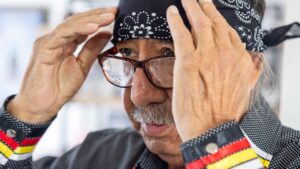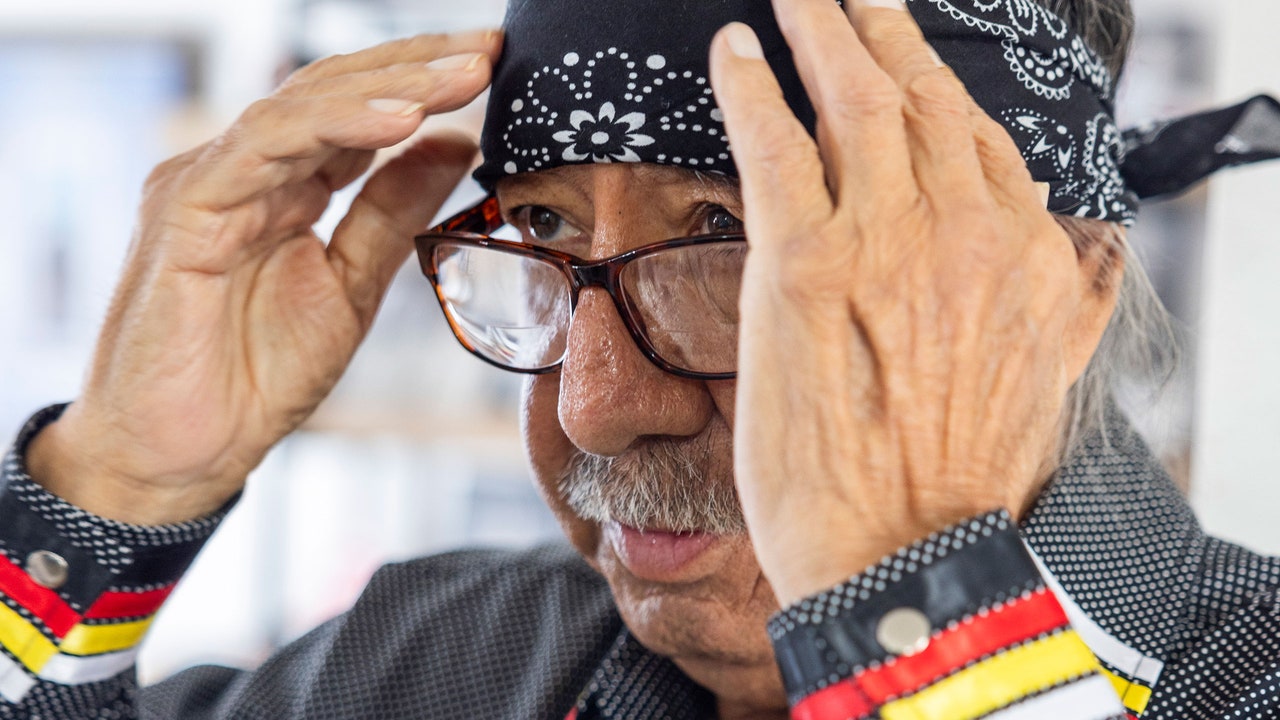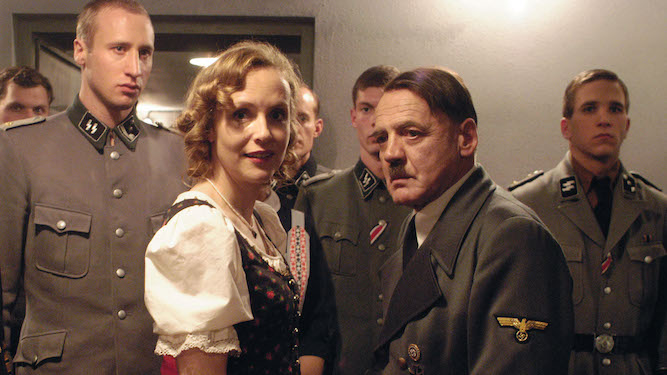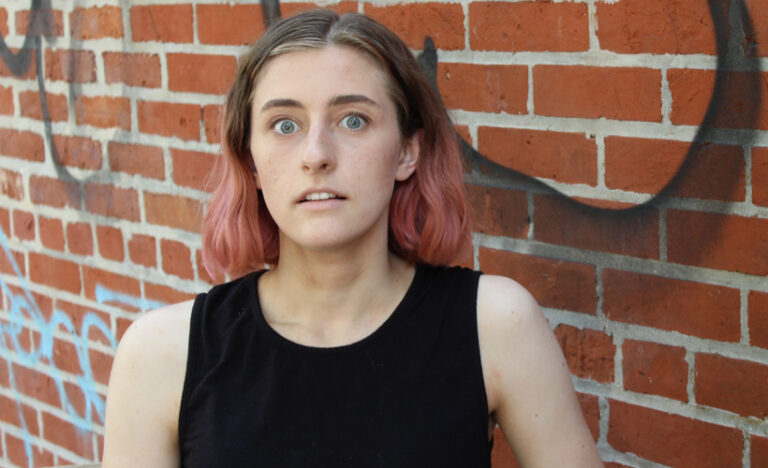Earlier this year, it seemed as though the final chapter of Leonard Peltier’s story had been written. The eighty-year-old is serving two consecutive life sentences for the 1975 killing of two F.B.I. agents, Ronald Williams and Jack Coler, which he says he didn’t commit. Having exhausted legal channels for appeal, and been denied parole, it appeared that he would die in prison. But, during the final moments of Joe Biden’s Presidential Administration, Biden commuted Peltier’s sentence to home confinement. Peltier is now home, at the Turtle Mountain Indian Reservation, in North Dakota.
When I called him after he got there, one of the first things he said to me was, “We were at war.” That war had already begun when Peltier was a child. In 1953, when Peltier was nine, Congress passed a bill to terminate his tribe, the Turtle Mountain Band of Chippewa. The government’s actions were part of an attempt to end the trust status of tribal lands and the protections that came with it. The Red Power Movement, which advocated American Indian political and cultural autonomy, arose to reverse this agenda, and activists such as Peltier came to see themselves as engaged in a twentieth-century battle akin to the one their ancestors staged in the nineteenth century against the tide of western expansion.
In 1972, Peltier joined the American Indian Movement, among the more confrontational Red Power groups, which had been founded, a few years before, by Dennis Banks, Clyde Bellecourt, and others. That fall, AIM helped organize a cross-country caravan called the Trail of Broken Treaties, which ended in the takeover of the Bureau of Indian Affairs headquarters, in Washington, D.C., demanding the repeal of termination legislation and renewing federal treaty relations with tribes. AIM brought together fellow-travellers from different tribes who shared similar life stories and who resolved to turn back the existential threats facing tribal life. Many had been taught to feel shame in Native culture and language at Indian boarding schools; others had been hardened by prison stints or by the harsh realities of urban poverty. All were trying to create meaning out of a life that seemed robbed from them. That meant survival by any means, and, as it had for their ancestors, that sometimes meant picking up a gun.
After the Trail of Broken Treaties, the F.B.I. also adopted tactics of war in its increased efforts against AIM. In 1973, the federal government conducted a seventy-one-day siege against hundreds of AIM members and dissident Oglalas who had holed up at Wounded Knee, the infamous massacre site on the Pine Ridge Indian Reservation, to protest a despotic tribal government led by a man named Dick Wilson. The government sent hundreds of F.B.I. agents, U.S. marshals, and others to the Wounded Knee trenches, armed with military equipment including armored personnel carriers and tear gas. Their opponents were armed mostly with hunting rifles. Federal forces killed two men during the siege, the first of many AIM deaths to come. Peltier, meanwhile, was sitting in a Milwaukee jail, facing a charge of attempted murder that stemmed from a different protest. He was later acquitted.
Violence only increased on the reservation in the wake of the occupation. Dick Wilson set his “GOON squad”—a private militia that he dubbed the Guardians of the Oglala Nation—to exact revenge on AIM and its supporters, and AIM retaliated. There were beatings and murders during what was dubbed the Reign of Terror. The increased presence of the F.B.I. in Pine Ridge didn’t help matters. By the spring of 1975, Peltier had set up camp on the reservation at Oglala, offering protection to elders. A confidential F.B.I. memo described the Bureau’s new function as a “paramilitary law enforcement operation in Indian Country.” The atmosphere in Pine Ridge was explosive.
On June 26, 1975, Agents Williams and Coler were at the reservation to serve warrants for robbery and assault, according to the F.B.I., when a shoot-out ensued. Peltier was arrested in Canada. His co-defendants, Bob Robideau and Dino Butler, were arrested in the U.S., tried first, and acquitted on the grounds of self-defense after their attorneys presented evidence of the volatile conditions on the reservation and the aggressive actions of the F.B.I. When Peltier was tried separately, several months later, a judge barred his defense from presenting similar evidence to a less sympathetic venue. An all-white jury convicted him of two counts of murder.
A few months after the shoot-out, another prominent member of AIM, Anna Mae Aquash, disappeared, and was later found dead. For years, rumors circulated that she had been murdered by other members of the group who suspected that she was an informant. Peltier was publicly linked to her killing, but he has denied any involvement and has never been charged. Others suspected an F.B.I. coverup. A confidential report detailed the Bureau’s likely knowledge of the murder months before the discovery of Aquash’s body.
Peltier spent the next five decades in federal prison, where he claims that jailhouse informants and would-be assassins presented new dangers. On the outside, his supporters raised his profile as a political prisoner, and the F.B.I. pushed back. In 2000, hundreds of agents marched in front of the White House, demanding that President Bill Clinton not grant Peltier clemency. In the two-thousands, two former AIM members were convicted of Anna Mae Aquash’s murder, although an alleged conspirator, Theda Nelson Clarke, was not indicted, and the trials seemed to produce more questions than answers.
Nonetheless, there continued to be overwhelming support for Peltier’s freedom in Indian Country, especially in the Pine Ridge reservation, where memories of the violence over a half century ago still feel fresh. The Standing Rock protests against the Dakota Access Pipeline, in 2016, catalyzed a new era of Native activism, and, in recent years, young Native activists took up Peltier’s campaign. His freedom was seen as part of a broader effort to address destructive federal policies, including the Indian boarding-school system, which Peltier was subjected to. When he crossed the reservation line this February, it was as though a prisoner of the country’s longest war had finally returned home.
We spoke, via Zoom, for several hours in the spring. Our conversation has been edited for length and clarity.
Can you start by introducing yourself?
My father was a French Chippewa Cree from Turtle Mountain. And my mother was Lakota and Chippewa from Spirit Lake. I was raised basically here on Turtle Mountain and what was called Fort Totten, in the past, but the real name, today, is Spirit Lake. I was raised in both Nations. And we’re Nations, we’re not reservations any longer. We have opened the doors to freedom as much as we can, but we still have a ways to go.
You’ve spent five decades behind bars. Did you expect President Biden to release you?
No. I honestly believed that they were just delaying, and I was going to die in prison. Some people told him, if he didn’t do something, it would be political suicide for the Democratic Party, because the Natives are going to move away from him. But that’s not the real reason he let me go—they were looking for a way to let me go. So I told Holly [Cook Macarro, a lobbyist and activist], “Ask him for clemency and ask him for home confinement.” That’s how we got home confinement.
Now I’m in my house. They bought me a house—the people. I want to cry every time I think about it, I’m so happy that my people have shown me love. For the first month, I thought I was dreaming. I thought I was going to wake up one morning and there I was in that prison cell again. But I’m still here. I got my own office and I’m sitting here drinking coffee, talking to you. I’m starting to believe that I’m really out.
A 1953 bill called for the termination of your tribe, the Turtle Mountain Band of Chippewa, at “the earliest possible time.” What was the situation like then, and how did it influence your becoming an activist?
It was 1953 when I was sent to the Wahpeton boarding school. My grandfather had died about six months before that. My grandmother was trying to get some assistance to feed me, my sister, and my cousin. She was living in the same house that we were raised in. They came, got us three kids, and put us in boarding school. I got out in 1956.
I came back here to Turtle Mountain to live with my dad and stepmother, and they were all organizing. I listened to some of the meetings they had, and they were talking about termination—that we were going to be the next reservation to be terminated, because we heard what was going on with the Menominees. They told my dad and his generation that they had to sign up for relocation, and that we were being terminated in Turtle Mountain, because it was too small of a reservation.
But my dad and his generation stood up to it, and told them, “No, you ain’t even paid us for the land you took already.” They took land from the Minnesota border all the way to Montana—they called it the Ten-Cent Treaty. They said our land was only worth ten cents an acre. It was filled with minerals, and it was probably one of the biggest ripoffs in the history of Native people.
The protest against termination was one of my first demonstrations. I was about thirteen. They took over the B.I.A. [Bureau of Indian Affairs] building. In the basement was the jail. They took over the jail and they occupied it all day. Celia Dakota, my stepmother’s sister, was doing most of the talking, and she was very angry. The superintendent was Mr. Rice. I’m standing in the back listening to all this, and the phone rang, and he answered the phone. When he hung up, he said, “I have to go now, you guys got to clear out. It’s my wife, and she said my dinner’s getting cold.” Ms. Celia got pissed off. She said, “You son of a bitch, my children are up home starving. You’re worrying about your goddam meal getting cold?” She started calling to hang him—literally, I’m not exaggerating. She said, “Somebody get a rope.” Nobody had a rope, thank God.
But he said, “I’ll make a phone call, let me call Bismarck.” [Bismarck was where the B.I.A. had its regional office.] And he called Bismarck. “These people are going to kill me, man,” he said. “They’re mad, they’re angry, they’re starving over here.” They said, “Tell them we’ll be there in the morning.” Next morning, two of them came down from Bismarck. They gave everybody a fifty-dollar voucher and said they stopped the termination of Turtle Mountain. That’s when I really started becoming an activist. But we didn’t call it activists. We called ourselves warriors for the people.
When I went to Washington State, I got involved in fishing and hunting demonstrations. My business partner, Howard Miller, was from Michigan. He was an older guy, and he and his wife, Mary Jane, were like a dad and a mother to me. We started a garage together and we got on the front page of the Seattle Times, and that brought in a lot of business—two Indian guys starting a garage in a big city. We came home about six every night, usually watching news while Mary Jane was cooking supper. I’m watching the news; there was the demonstration about fishing and hunting, and cops are beating up this girl. I don’t know how old she was, but her little boy was probably five years old. They tore her blouse. That’s one of the things they always did to the women is tear their blouses to embarrass them. And they’re beating the shit out of her. Her little kid come running up, “Don’t hit my mama no more.” So they started hitting him. I told Howie, “You can have all this. I’m going to go fight with these people.” I couldn’t get out of my mind what I’d just seen.
You gave up your garage. How did you join the American Indian Movement?
I went to Denver and met Vernon Bellecourt. He started telling me about the American Indian Movement. I said, “Can anybody join?” I gave him a little history of my activism. He said, “We’re looking for new recruits all the time. We’re going down to a convention at Leech Lake, and I would like to have you guys travel with me.” I went to Leech Lake, and I heard Dennis Banks talk. I said, “Man, this guy can speak. This is the kind of leadership we need.”
[In April, 1974, three white teen-agers killed three Navajo men near Farmington, New Mexico. The incident, known as the Chokecherry Massacre, spurred major protests; the following year, AIM held its convention in Farmington. A few months before the convention, a close confidant of Dennis Banks’s was outed as working for the F.B.I., which fuelled growing paranoia within the group.] Suspicions also swirled around your friend Anna Mae Aquash. It was quite shocking that the Aquash murder trials went forward because there was no physical evidence; it was all hearsay. But, during the trials, you were named as someone who interrogated Aquash for being an informant.
I didn’t carry power to order somebody killed. Anna Mae was my friend. She came with us to Farmington. We pulled into where they told us to set up our camp. Ka-Mook [another member of AIM, also known as Darlene Nichols] came out and said, “Leonard, they’re having a meeting in there about Anna Mae.” I said, “About what?” She said, “Well, they think she’s a rat.” I said, “That’s bullshit. She’s been with us all this time, and I would’ve found out by now she was a rat.” She said, “Well, that’s what they’re saying in there. I just thought I’d come out and tell you this.”
I went in there and I asked them, “What’s this about Anna Mae, man?” They said, “Well, we got evidence.” I said, “I don’t believe that for a minute. She’s been with us for the last six months. I would’ve found out by now. Don’t anybody touch her because if you do, I’m turning against you, I’m coming after you. She is not a rat, don’t be putting that shit on people, that’s not true.” In fact, I told them, I’m going to go and interrogate her again. I never interrogated her before. I told her, “Let’s go sit behind a tree over here for a while.” So we did. Then I came back and I said, “No, I believe now fully, she’s not a rat.”
Anna Mae split from there because she was scared. A lot of people were looking at her weird.
It’s interesting that Ka-Mook was in this meeting and then came out and told you this. She was a key witness in the Aquash homicide trials. [Ka-Mook, who was in a common-law marriage with Banks, subsequently worked with the F.B.I., secretly taping conversations with Banks and others.]
She hated Anna Mae. She tried to say Anna Mae was her best friend. Anna Mae was sleeping with Dennis, and she hated it. [Ka-Mook told the Times that she and Aquash got along fine.]
I took Anna Mae behind the tree line and we had sat down and talked. I told her, “Make off like I really got rough with you—cry to the other women. We got to make this believable.” What did we do? We smoked a joint, sat back, laid in the sun, laughed. That’s all we did to cover her trail so nobody would try to take a pot shot at her. We created that story. She took off right after that. I don’t know who she left with. We knew she was O.K., but we left before the convention was over.
Ka-Mook said that Anna Mae told people that you put a gun to her head during the interrogation. Are you saying this was a cover story that you and Anna Mae made up?
Yeah, a cover story. It’s an old tactic in any movement to clear somebody up that’s being falsely accused of something like this.
Were there any threats to the camp before the shoot-out? Did you get any indication that something was about to pop off?
Yes. We’d seen helicopters flying over that land, all around there. We found out that those helicopters were taking surveillance surveys. And somebody that was familiar with it said they’re doing a survey of this whole area—they were possibly going to prepare an attack there. Later, during the shoot-out, we’d seen these same helicopters flying over us. They weren’t just surveyors like they told everybody, because some of the people went and complained, “Hey, why is this helicopter flying over our property with big old machines hanging out underneath it?”
These kids would be walking around down the road and the F.B.I. would pick them up and take them down to the jail to be interrogated, then tell them to walk home. That was illegal. Agents were walking to the Oglala housing, they were just walking indoors and looking, supposedly, for Jimmy Eagle, who supposedly stole a pair of used cowboy boots.
We knew what they were doing. They had everybody in the community housing very pissed off. People were saying, “They wouldn’t do that to a white man coming in, just walk in their house.” That terrified a lot of the elders. Those were terror attacks, acting like a bunch of Storm Troopers. That’s the language people started using during the Reign of Terror. This was the F.B.I. doing this. They deny it, but that’s true. That’s why people got scared and paranoid, and a lot of them believed that something was going to happen, especially with those helicopters flying around. What we heard from people that were in intelligence is that they used to scope out for a lot of tunnels and stuff like this back in Vietnam—same machines, they were claiming. People started getting paranoid.
Were a lot of those people in Oglala present when the shooting started, on June 26th?
I can’t say that for sure, so I’m not going to say anything about it. I’m not going to say who did what or who killed who. Were they participating and fighting? I would say, yes, they did. They believed they were protecting their home, because, by the time this was going on, they were surrounded by the F.B.I. SWAT teams. How did they get there so soon? That’s the thing we’ve always asked.
There were families living in these homes caught in a crossfire.
Yeah. And everybody’s home. We were prepared for that because Dennis was living there with his kids and so were the other people. They were taught to be prepared for any attack, which trail to take. That’s why they all got away even with being surrounded. There was a family living in one of them small houses; I ran up there and got those people out of there immediately. One guy was running across the field, they started concentrating on him. And, well, I got the family and I got them out of there, too. They knew what to do anyway—that’s why a lot of them were not in the middle of the firefight. Not saying I’m a hero, but I’m proud of being able to do that.
You’re saying you did what you came to do. How did you get your group out?
We saw that we were surrounded completely, so we were trying to figure out how in the hell are we going to get out of there. We stopped and said a prayer. We prayed to the Great Spirit to help us. As we were moving, I saw this big bird fly out of the trees and it flew a certain way. I said, “Looks like this eagle, maybe he’s taking us out of here.” Now, this ain’t no bullshit, this ain’t no fantasy, this really happened. It led us to a culvert, and that’s how we got out of there. As we were getting close, the police cars left. They didn’t see us, so they left, moved on to something else.
And what was your thinking at that time? Was there a plan or were you just trying to—
We were trying to get away, there were no plans. But then, once we got to the hillside, Oglala people came to our rescue and led us out of there. Two young Oglala people came on horses and led us out. They risked their lives and their safety for what was going on. That wasn’t bullshit, that’s the only way we could’ve got out of there, because they had us surrounded.
Once you got out of there, you and Dennis later caught up with each other, but what happened in between?
Ka-Mook went to her family’s home in the Oglala community and Dennis happened to just go by himself, with the security, to the trial. [Banks faced trial in South Dakota for his role in a 1973 riot at the Custer County courthouse.] I ran in with Dennis later, and we sat around and talked about it. He said, “I don’t want to go to prison, I might never get out of there.” I said, “I don’t think it’ll come from any Natives in there, we might have a couple, two, three that are jealous, but the majority of them in there are going to protect you, so we don’t need to worry about that, we need to worry about the staff and the rednecks in there.” We made a decision: he wasn’t going to surrender to the conviction. We had more and more people coming to us, and the F.B.I. was going crazy—they were wearing uniforms like military and coming into homes acting like Gestapos.
It wasn’t just in the Oglala community; it was happening all over the reservation. We needed protection, we needed arms. So we went to Los Angeles and got some help. We raised some money. Another friend bought a bunch of weapons. The people were terrified at what the F.B.I. was doing in those military uniforms and fatigues, and we were going back to help them, we’d fight for them, that’s what we were going to do.
Your goal was to go back to Pine Ridge?
Yes.
How did you end up in Oregon?
We were in Seattle. We realized that this person’s home that was protecting us was being surveilled, and so we said, Let’s move. He was a pretty big activist himself. We left and travelled across Oregon. I’m not sure now where the hell we were heading—I think it was back to South Dakota, really. And we got stopped in Oregon. [While in Oregon, Peltier was pulled over by police officers. He fled and was shot.]
At that point, Anna Mae had reconnected with you as well.
While we were there, she hooked up with us again. So if I had treated her the way everybody claims—if I put a gun to her head—she would’ve never showed up. That was a lie. I already interrogated her about being a pig informer. And the real truth was all we did was sit around and laugh about it, that was my interrogation. Because I knew she wasn’t, I just knew it. Some of the things that we were involved in, the cops would’ve known, and they never did know. They never brought it up, so they didn’t know about it.
We made a lot of shit up to throw them off. People on phones that we knew were being tapped, they would say, “Dennis and Leonard are coming in tonight, be ready.” And then hang up the phone, and we were probably fifteen hundred miles away from there. A lot of people did that, both Natives and non-Natives.
After getting stopped in Oregon, you left for Canada.
I left way later. We sat around with all the elders, and we couldn’t figure out who were the informants. One of the things that we talked about was perhaps we should go to Canada and ask for asylum.
When I got shot in the back by the cops, on the shoulder, I had to try to get the bullet out. And so I went to these people, they put me in their attic. A doctor came and he tried to dig out that bullet, but he couldn’t get at it. They gave me a shot for pain and got to digging, but he couldn’t find it. “You got to get an X-ray.” I said, “To hell with it, just leave it in there.” It’s still there, fifty years later.
Any place I went, we had those type of people supporting us. If we were mad-dog killers like they tried to say we were, those people ain’t going to support us. Our people don’t support mad-dog killers. There was an actual war going on—they were going to wipe us all out if they could. So they did us a favor by pulling us over in Oregon and starting shooting. The cop was shooting around like he was a goddam—I don’t know, he must have thought he was a hero or something.
I had to get away to distract him because Ka-Mook was pregnant, Anna Mae and them were there, and we had two small kids. What if I had a gun? I wouldn’t have shot back anyway because I knew where the kids were, and they were all crying. So I get shot, but I still got away.
I went to Canada. I figured that we’d get more information about who were the informants that were turning against the Oglala Nation. And I went over, got arrested, and, early in the morning, they flew me into British Columbia. They brought me to one of the most conservative judges. I had two lawyers. The Native people there and the Native people from America, they came to my support and my rescue.
We found out that they had this woman [Myrtle Poor Bear] who I’d never met in my life. She was an Oglala, she came from the Poor Bear family, which is a big family. But she claimed that she was my girlfriend and she was an eyewitness to the killings. That’s totally untrue, which was proven beyond a shadow of doubt—it was all fabricated.
They promised us that they would give me a fair trial. But with the Myrtle Poor Bear stuff, I knew that was a lie. They had taken me from Cedar Rapids, Iowa, where I was supposed to go to trial, but mysteriously they gave me a change of venue, to Fargo, North Dakota, a hotbed of extreme racism against Native people. In the middle of the trial, we find out that one of the jurors was a racist. She had made derogatory statements about Native people. My lawyer agreed to keep her on, but that juror should be immediately dismissed. That didn’t happen, and, of course, they all came back with a guilty verdict.
The next issue was we uncovered evidence that cast doubt on whether the murder weapon was the murder weapon. Years later, we found evidence they had done firing-pin tests on this weapon that came out negative, so this was not the murder weapon. [The government claimed that the October, 1975 F.B.I. Laboratory teletype cited by Peltier was an interim report that did not include results from later ballistic tests, and therefore did not undermine its case against him.]
You talked about this being at war with the United States government and the tactics they were using—and this extended beyond Pine Ridge, and went into the prison. There’s the case of Robert (Standing Deer) Wilson, who approached you and basically confessed to being paid to put a hit on you. Can you talk about that interaction with him, and what led to your attempts to liberate yourself from prison?
Well, Standing Deer, to be honest about it, was a little bit smarter than the rest of the informants. He had a charge for robbing a bank when he injured a cop, right? And they don’t make deals with people like that—very rarely. So, when he made a deal with them, he made them sign the papers that he would be totally exonerated from that charge, and that’s what made me believe that he was telling the truth—because he showed me the papers where they discharged that shooting of the cop.
When he showed me the paperwork, I confronted him directly, and I said, “So what are you going to do about it? Come on, let’s get it over with.” And he said, “No. I’ve been reading about your case, I’ve been reading about the Native people, I don’t want to come back to white people.” He said, “I want to fight for our people—I don’t want to be here, that’s why I’m telling you this.” That’s how he revealed himself and we accepted him. He crossed over from their side to ours.
He, as far as I know, didn’t really connect with his Indigenous identity. And judging from Peter Matthiessen’s book about your case, “In the Spirit of Crazy Horse,” it sounds like you helped him reconnect. Was that a common thing for you, to connect Indigenous brothers on the inside with the spirituality, and really push that?
Yes. Without being a brag or trying to say I was anybody special, when I got to prison, I’d already been very popular among Indian people in the streets, and so was the American Indian Movement. And so a lot of people immediately came to my rescue, let’s say. Different groups of people came to me and told me, “We’re behind you, anybody tries any bullshit, we’re behind you.” And some of these guys were big gang members, people who had a reputation of being, well, warriors. So that was a lot easier for me to be accepted by Native people.
And a lot of Native people came to me and said, “We want to be part of you guys, we want to fight for our people.” So I got a lot of protection in that way. Although I don’t know anybody that was really up to kill me—the F.B.I., I know they tried to make it sound like I needed protection. That was not true.
And now, after nearly fifty years, you’re sitting at home. What do you want the world to know about your case?
The world should know what America has done. I was no more guilty than my co-defendants, and they were found not guilty by reason of self-defense, because the jury heard what was going on, and they said that should not be done to any American. Native people have just as much right to defend themselves as any other race in the United States or around the world. I did not get a fair trial—all you got to do is read the court’s records.
This has been happening to us for hundreds of years, facing these types of trials. I’ve had a great-great uncle that was hung as one of the Dakota Thirty-eight. [In 1862, multiple Dakota groups took up arms against white settlers and members of the U.S. military. The government later executed thirty-eight men who were involved.] They hung thirty-eight of us at one time on bullshit evidence, five-minute trials with no appeals. This is what happened to us, this is just one incident of so many.
Who was that great-great uncle?
His name was White Dog. He was a brother to my great-great grandmother named Tatewikuwa, the Wind Chases the Sun—that’s my family name. But they hung him. And the reason they hung him was even more outrageous. He was walking around on the reservation and he seen this white woman looking for something to eat, wild vegetables. They looked at each other and at first she panicked and thought, Oh, my God, this guy’s going to kill me, rape me, and kill me. That’s what they were saying about Native people, that Native men see a white woman and they want to rape her and kill her. Well, that was not true, it never has been true. If anything, it was the total opposite. Her kids were hungry at home. He wasn’t doing anything that showed her that her life was in danger. They started talking. She told him, “My husband got killed and my kids are at home hungry because they ain’t got no food.” So he started helping her. He felt sorry for her. She kept telling the story that she wasn’t the only one. He asked her, “Do you have a gun?” She said, “Yes, but I only have one bullet.” He said, “Let me use it, I’ll get you a deer.” So he brought back a deer. The next day they were all happy and he came by to see if they were O.K.
He started teaching them how to hunt. And in those days, they had what were called wood buffalos. So he killed one of them, dressed it, and brought it back to the community. He was one of the guys arrested with all the Dakota men, young boys. A soldier pulled White Dog out of line. He was going to put him in the group that was going to be hung. She started begging for his life, and that only infuriated the captain, and they hung poor White Dog, too. He was innocent and he got hung. That’s part of the history of the family that was happening to us.
How do you want your story to end?
I want the people to read and know the history of what happened to Native people, the true history, the genocide, the mass murders, the killing of people—little girls, our great-great grandmothers—and enslaving our children. And I want the world to know what they did, how they did it. Not once have they ever apologized for all that brutality. They’re doing it again. Look what’s happening in Palestine. They’re murdering women, children, babies. I want that story told with my story, that’s what I’m about. I want to tell people what they did to me in the courtroom. If I would’ve been allowed to give my defense, I would’ve never gone to prison. I want the world to know what they did. I want the world to know that they’re still doing it in America.
Then, I could probably die happy—the main thing is to tell the story of what they did to us. To hell with Leonard Peltier! I want you to know what we were fighting for, and that was the truth. That’s why so many Indian people support me; they know what happened. They know what was going to happen to us, and they support me for that. I would like to hear and read this story from our point of view, a Native point of view. ♦







